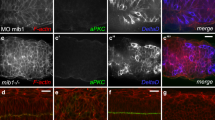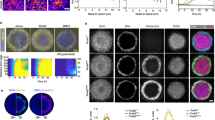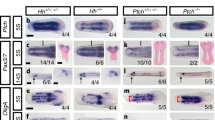Abstract
Zebrafish cyclops (cyc) mutations cause deficiencies in the dorsal mesendoderm1,2 and ventral neural tube3,4, leading to neural defects and cyclopia5,6. Here we report that cyc encodes a transforming growth factor-β (TGF-β)-related intercellular signalling molecule that is similar to mouse nodal7. cyc is expressed in dorsal mesendoderm at gastrulation and in the prechordal plate until early somitogenesis. Expression reappears transiently in the left lateral-plate mesoderm, and in an unprecedented asymmetric pattern in the left forebrain. Injection of cyc RNA non-autonomously restores sonic hedgehog -expressing cells of the ventral brain and floorplate that are absent in cyc mutants, whereas inducing activities are abolished by cycm294, a mutation of a conserved cysteine in the mature ligand. Our results indicate that cyc provides an essential non-cell-autonomous signal at gastrulation, leading to induction of the floorplate and ventral brain.
This is a preview of subscription content, access via your institution
Access options
Subscribe to this journal
Receive 51 print issues and online access
$199.00 per year
only $3.90 per issue
Buy this article
- Purchase on Springer Link
- Instant access to full article PDF
Prices may be subject to local taxes which are calculated during checkout




Similar content being viewed by others
References
Thisse, C., Thisse, B., Halpern, M. E. & Postlethwait, J. H. goosecoid expression in neurectoderm and mesendoderm is disrupted in zebrafish cyclops gastrulas. Dev. Biol. 164, 420–429 (1994).
Warga, R. Origin and Specification of the Endoderm in the Zebrafish. Thesis, Univ. Tubingen(1996)).
Hatta, K., Kimmel, C. B., Ho, R. K. & Walker, C. The cyclops mutation blocks specification of the floor plate of the zebrafish central nervous system. Nature 350, 339–341 (1991).
Hatta, K., Puschel, A. W. & Kimmel, C. B. Midline signaling in the primordium of the zebrafish anterior central nervous system. Proc. Natl Acad. Sci. USA 91, 2061–2065 (1994).
Hatta, K. Role of the floor plate in axonal patterning in the zebrafish CNS. Neuron 9, 629–642 (1992).
Macdonald, R.et al. Regulatory gene expression boundaries demarcate sites of neuronal differentiation in the embryonic zebrafish forebrain. Neuron 13, 1039–1053 (1994).
Varlet, I., Collignon, J., Norris, D. P. & Robertson, E. J. Nodal signaling and axis formation in the mouse. Cold Spring Har. Symp. Quant. Biol. LXII, 105–113 (1997).
Tanabe, Y. & Jessell, T. M. Diversity and pattern in the developing spinal cord. Science 274, 1115–1123 (1996).
Chiang, C.et al. Cyclopia and defective axial patterning in mice lacking Sonic hedgehog gene function. Nature 383, 407–413 (1996).
Pituello, F., Yamada, G. & Gruss, P. Activin A inhibits Pax-6 expression and perturbs cell differentiation in the developing spinal cord in vitro. Proc. Natl Acad. Sci. USA 92, 6952–6956 (1995).
Artinger, K. B. & Bronner-Fraser, M. Delayed formation of the floor plate after ablation of the avian notochord. Neuron 11, 1147–1161 (1993).
Halpern, M. E.et al. Genetic interactions in zebrafish midline development. Dev. Biol. 187, 154–170 (1997).
Krauss, S., Concordet, J. P. & Ingham, P. W. Afunctionally conserved homolog of the Drosophila segment polarity gene hh is expressed in tissues with polarizing activity in zebrafish embryos. Cell 75, 1431–1444 (1993).
Toyama, R., O'Connell, M. L., Wright, C. V. E., Kuehn, M. R. & Dawid, I. Nodal induces ectopic goosecoid and lim1 expression and axis duplication in zebrafish. Development 121, 383–391 (1995).
Varlet, I. & Robertson, E. J. Left-right asymmetry in vertebrates. Curr. Opin. Genet. Dev. 7, 519–523 (1997).
Postlethwait, J. H.et al. Agenetic linkage map for the zebrafish. Science 264, 699–703 (1994).
Talbot, W. S.et al. Genetic analysis of chromosomal rearrangements in the cyclops region of the zebrafish genome. Genetics 148, 373–380 (1998).
Schier, A. F.et al. Mutations affecting the development of the embryonic zebrafish brain. Development 123, 165–178 (1996).
Kingsley, D. M. The TGF-β superfamily: new members, new receptors, and new genetic tests of function in different organisms. Genes Dev. 8, 133–146 (1994).
Mason, A. J. Functional analysis of cysteine residues of activin A. Mol. Endocrinol. 8, 325–332 (1994).
Ekker, S. C.et al. Patterning activities of vertebrate hedgehog proteins in the developing eye and brain. Curr. Biol. 5, 944–955 (1995).
Brand, M.et al. Mutations affecting development of the midline and general body shape during zebrafish embryogenesis. Development 123, 129–142 (1996).
Strahle, U.et al. one-eyed pinhead is required for development of the ventral midline of the zebrafish (Danio rerio) neural tube. Genes Funct. 1, 131–148 (1997).
Zhang, J., Talbot, W. S. & Schier, A. F. Positional cloning identifies zebrafish one-eyed pinhead as a permissive EGF-related ligand required during gastrulation. Cell 92, 241–251 (1998).
Butler, A. B. & Hodos, W. (eds) Comparative Vertebrate Neuroanatomy: Evolution and Adaption (J. Wiley, New York, (1996)).
Chen, J.-N.et al. Left-right pattern of cardiac BMP4 may drive asymmetry of the heart in zebrafish. Development 124, 4373–4382 (1997).
Pera, E. M. & Kessel, M. Patterning of the chick forebrain anlage by the prechordal plate. Development 124, 4153–4162 (1997).
Dale, J. K.et al. Cooperation of BMP7 and SHH in the induction of forebrain ventral midline cells by prechordal mesoderm. Cell 90, 257–269 (1997).
Heisenberg, C. P. & Nusslein-Volhard, C. The function of silberblick in the positioning of the eye anlage in the zebrafish embryo. Dev. Biol. 184, 85–94 (1997).
Knapik, E. W.et al. Amicrosatellite genetic linkage map for zebrafish. Nature Genet. 18, 338–343 (1998).
Feldman, B.et al. Zebrafish organizer development and germ-layer formation require nodal-related signals. Nature(in the press).
Rebagliati, M. R., Toyama, R., Fricke, C., Haffter, P. & Dawid, I. B. Zebrafish nodal-related genes are implicated in axial patterning and establishing left-right asymmetry. Dev. Biol. 199, 261–272 (1998).
Rebagliati, M. R., Toyama, R., Haffter, P. & Dawid, I. B. cyclops encodes a nodal-related factor involved in midline signaling. Proc. Natl. Acad. Sci. USA 95, 9932–9937 (1998).
Acknowledgements
We thank C.-M. Fan, B. Hogan, R. Warga and I. Dawid for discussion; W. Driever, E.Knapik, M.Fishman, C. B. Kimmel, S. Ekker, J. Campos-Ortega, D. Kimelman, D. Wilkinson, D. Turner and C.Nüsslein-Volhard for reagents or zebrafish; S. Fisher, A. Switalski, A. Chilcoat and L. Friedman for map panel DNA; and M. Macurak, A. Pinder, M. Sepanski, D. Lee, B. Cortez, A. Hennessey, M. Ray and K. L. Poon for technical assistance. K.S. and V.K. are supported by NSTB, Singapore; A.L.R., A.M.S.C. and J.O.L. by NIH Training Awards; L.S.K. by the NIH and March of Dimes Birth Defects Foundation; M.E.H. by NSF and the Pew Scholars Program; and C.V.E.W. by the NIH.
Author information
Authors and Affiliations
Rights and permissions
About this article
Cite this article
Sampath, K., Rubinstein, A., Cheng, A. et al. Induction of the zebrafish ventral brain and floorplate requires cyclops/nodal signalling. Nature 395, 185–189 (1998). https://doi.org/10.1038/26020
Received:
Accepted:
Issue Date:
DOI: https://doi.org/10.1038/26020
This article is cited by
-
Camel regulates development of the brain ventricular system
Cell and Tissue Research (2021)
-
An enigmatic translocation of the vertebrate primordial eye field
BMC Evolutionary Biology (2020)
-
Pcdh18a regulates endocytosis of E-cadherin during axial mesoderm development in zebrafish
Histochemistry and Cell Biology (2020)
-
Scale-invariant patterning by size-dependent inhibition of Nodal signalling
Nature Cell Biology (2018)
-
Analysis of novel domain-specific mutations in the zebrafish ndr2/cyclops gene generated using CRISPR-Cas9 RNPs
Journal of Genetics (2018)
Comments
By submitting a comment you agree to abide by our Terms and Community Guidelines. If you find something abusive or that does not comply with our terms or guidelines please flag it as inappropriate.



